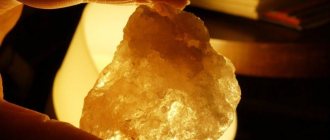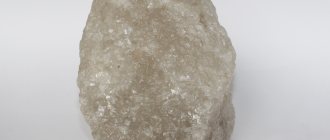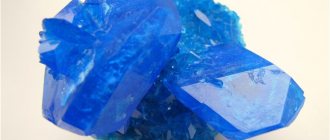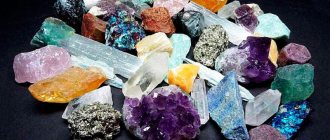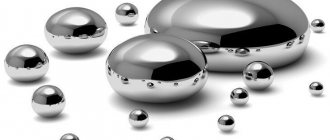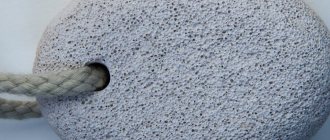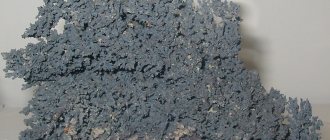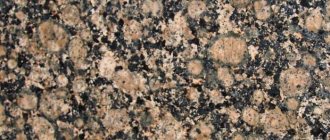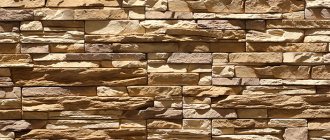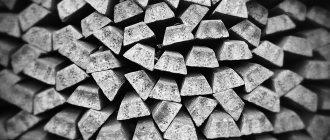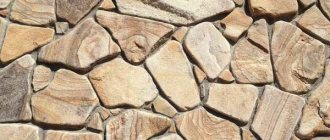Halite is a natural mineral of the halogen class, subclass sodium chloride. For an ordinary person, this is rock table salt, which is used daily for food. The history of the mineral goes back to the era of the origin of life on the planet, when the water in the world’s oceans was already salty. That is why the Ancient Greeks called it “halite”, which means “sea”, “salt”.
The chemical formula of halite is NaCl, contains 60.6% chlorine and 39.4% sodium. A pure mineral is transparent, opaque or translucent, colorless or white with a glassy sheen. Depending on additional impurities, it may have shades: with iron oxide - yellow and red tones, organic inclusions - colors from brown to black, clay impurities - gray shades. An interesting blue and lilac color is given to halite by an admixture of sylvite (potassium chloride).
Halite is a brittle mineral with hygroscopic properties and a salty taste. It easily dissolves in water, melts at temperatures above 800°C, and colors the fire yellow. When mined, it is released in the form of cubic crystals or stalactites with a granular and spar-like structure. It has a conchoidal fracture, perfect cleavage, and is found in the rock with borates and sulfates formed during the evaporation of salt waters.
Features of storage and care
Products made from halite are sensitive to moisture and are short-lived due to their natural fragility. To maintain their original appearance, they must be wiped with alcohol, high-quality gasoline, or rinsed in a strong salt mixture, and then polished with a velvet cloth.
Table salt should be in closed containers or linen bags, and the room should have a low humidity level. When cooking, salt should only be taken with a dry spoon.
Halite used for technical purposes is recommended to be stored indoors. If it is located outdoors, then the site must be asphalted, equipped with a canopy and a drainage system.
Varieties of halite
Depending on the physical properties and origin, halite is divided into the following categories:
- Rock salt is formed during the compaction of sedimentary deposits of halite formed in past geological eras. Occurs in the form of large massifs in layers of rocks;
- Self-sedimented salt is a rock formed in evaporite deposits in the form of druses and fine-grained deposits;
- Volcanic halite is asbestos-type aggregates formed during the vulcanization process. They are mined in places where lavas pass and where craters are located;
- Salt marsh is a salt efflorescence that forms in steppe and desert areas on the soil surface in the form of crusts and deposits.
Production technology
Natural mineral deposits contain undesirable components. They are removed during the production of bath stones using special cleaning technologies. Crystal clear salt mass is formed into pieces or monolithic materials under high pressure.
Only Himalayan salt is not purified. The value of this mineral is due to the high content of iron in its composition. Altai and sea salt are removed from excess moisture by evaporation.
Mineral deposits
Large deposits of halite were formed hundreds of millions of years ago in North America and Eurasia during the Permian period, when these areas were characterized by a hot and dry climate.
In modern times, rock salt is mined in large quantities in Russia - in the Solikamsk and Sol-Iletsk deposits of the Urals, the Usolye-Siberian basin, located in the vicinity of Irkutsk, the Iletsk districts of the Orenburg region, the Solvychegodsk deposit of the Arkhangelsk region, as well as the Verkhnekamsk region, located in the vicinity of Perm. Self-sedimented halite is developed in the Lower Volga region and coastal areas of Lake Baskunchak in the Astrakhan region.
In Ukraine, rock salt deposits are located in Artemovsk, Donetsk region and Transcarpathia. Lake Sivash in Crimea is famous for its self-planted rocks. Unusually beautiful, large crystals are mined in Poland - Inowroclaw, Bochnia and Wieliczka. Halite of blue and lilac shades is found in deposits in Germany located near Bernburg and Strasbourg.
Large quantities of halite are mined in the American states of New Mexico, Louisiana, Texas, Kansas, California and Oklahoma. In India, development is taking place along the Himalayan mountain range in the state of Punjab. Salt of lake origin is also formed in the Iranian Urmia deposit. Back to contents
Main characteristics of rock salt
The mineral halite received its scientific name in Ancient Greece. The translation of this word is ambiguous, but its meaning is two concepts - sea and salt. The chemical formula of rock salt is simple - it is NaCl as the main substance and other elements as impurities. Pure rock salt contains 61% chlorine and 39% sodium.
In its pure form, this mineral can be:
- transparent;
- opaque but translucent;
- colorless or white with signs of glassy luster.
NaCl
However, pure NaCl is rare in nature. Its deposits can have shades of colors:
- yellow and red (presence of iron oxide);
- dark - from brown to black (admixtures of decomposed organic matter, for example, humus);
- gray (clay impurities);
- blue and lilac (presence of potassium chloride).
Halite is fragile, hygroscopic and, of course, has a salty taste. The mineral dissolves well in water at any temperature, but melts only at high temperatures - not lower than 800°C. When fire melts, it turns yellow.
The crystalline structure of rock salt is a dense cube, the nodes of which contain negative chlorine ions. The octahedral voids between the chlorine atoms are filled with positively charged sodium ions. The structure of the crystal lattice is an example of ideal order - in it, each chlorine atom is surrounded by six sodium atoms, and each sodium atom is adjacent to the same number of chlorine ions.
Ideal cubic crystals in some deposits are replaced by octahedral ones. In salt lakes, crusts and druses can form at the bottom.
The magical properties of halite
Widespread and simple in composition, halite, at first glance, does not have a supernatural purpose, but the magical potential, prayed for by people for many centuries, helps to increase good and fight evil.
There are many signs and sayings associated with salt, which were formed by the people of different countries based on observations. It was believed that a handful of halite, sprinkled on the ground in the form of a cross, protects against evil spirits. On the other hand, spilled salt was perceived by many people as a signal of impending trouble and disease. The Slavs, when going on a campaign or to war, always took with them a handful of earth mixed with salt to protect themselves from mortal wounds.
To this day, magicians and sorcerers use halite in occult rituals. Halite increases good intentions many times over, but the mineral will return evil and envy like a boomerang in multiplied quantities. Spells with halite for good luck, love and happiness are effective, but for them to work you need to carry talismans with you. A pinch of crushed salt is sewn into children's clothes to protect them from damage and the evil eye. A mineral amulet protects its owner from emergencies, natural disasters and violent acts.
Halite, as a talisman, does not like extraneous energy and, when exposed to public display, can absorb someone else's negativity. To prevent this from happening, it is necessary to keep secret the composition of the talisman or amulet and hide it from prying eyes.
Back to contents
Medicinal properties
Mineral halite
Halite has unique antiseptic properties and is an effective method for treating colds and viral diseases. They are used to gargle when the first symptoms of sore throat, laryngitis or tonsillitis, as well as oral infections, appear. Halite salt (1 tablespoon), diluted in a glass of warm water, relieves toothache.
Warming with halite is recommended for the treatment of purulent abscesses on the skin, otitis media and radiculitis. To do this, small crystals of the mineral are placed in a bag, heated and applied to the sore spot.
To treat diseases of the lungs and bronchi, air saturated with halite ions is used. In hospitals and sanatoriums, salt rooms are set up for this purpose, and at home you can improve your health with the help of a salt lamp.
Staying in a salt room (halochamber) helps with nervous system disorders - eliminates anxiety, unreasonable fears and depressive mood, and normalizes sleep.
However, therapeutic procedures with halite may be contraindicated. The risk group includes persons who are diagnosed with:
- salt allergy;
- kidney disease;
- arterial hypertension;
- diseases of the heart and vascular system;
- epilepsy;
- oncological diseases;
- tuberculosis;
- severe mental disorders;
- blood diseases that contribute to bleeding;
- post-stroke and post-infarction conditions;
- drug addiction.
In such cases, before manipulating with salt and visiting the salt room, it is advisable to consult your doctor.
Procedures with salt are strictly contraindicated in acute inflammatory processes, abscesses and elevated body temperature. Back to contents
Contraindications
Salt, as a medicine, has contraindications. People with certain medical conditions are advised to reduce their salt intake. It is capable of retaining fluid in the body, and this provokes swelling and increased blood pressure. People who have various inflammations, obesity, kidney disease, hypertension need to reconsider their attitude towards salt.
Salt has always been highly valued. Wars broke out because of it, and in Africa you could buy a slave for a couple of pieces of halite. Every year, humanity consumes more than 10 million tons of salt in food. Halite is a unique crystal, which is the same age as the planet Earth, is used in industry, magic, medicine, cooking, and it is mentioned more than other crystals in folklore.
Application
Halite is used in many industries. In the food industry, it is used as an essential nutritional element - salt, which is included in the diet of every person. Up to 7 million tons of mineral are spent annually for these needs.
The chemical industry uses halite to release chlorine and sodium, from which soda, concentrated alkaline compounds and hydrochloric acid are subsequently made. Halite is present in household detergents, paper and glass. Monocrystalline halite film is used in high-quality optics on lenses as an additional layer.
Other industries use halite to process leather, produce aluminum and batteries, as a component of nuclear reactors, and to regenerate oxygen in submarines and missiles.
Using pressed technical halite, scale is removed from boilers and water heating elements are cleaned. The mineral concentrate is considered an effective means of combating icing. The freezing point of halite is lower than that of water, which allows the formation of an ice crust to reduce its density and adhesion to the road surface. The mineral is used in construction and exploration work in frozen areas to thaw the soil.
The mineral druses are exhibited in collections and are also used to make crafts, jewelry, talismans and amulets. It produces amazing interior items - cylinders, pyramids and balls with natural shapes and soft colors. Halite is capricious and requires proper care, so it is rarely used in jewelry.
How to decorate a bathhouse with it
It is best to use Himalayan salt blocks for these purposes. The mineral is enriched in magma. The finishing material is obtained from it using special technology. It has a high degree of strength and can withstand significant loads.
To reduce the cost of decorating a bathhouse with Himalayan salt slabs, you can limit yourself to fragmentary wall decoration. It is best to use this material in finishing dressing rooms, not steam rooms. It is much easier to maintain the humidity necessary to maintain the integrity of the material.
The plates are attached to the surfaces with a special two-component glue, which is made on the basis of magnesite. It is mixed with magnesium chloride in a ratio of 3:5. First, magnesium chloride is dissolved in warm water, and then magnesite is added to it. The average consumption of such glue is 1 kg per 1 sq. m.
Laying slabs on such adhesive must be done extremely carefully, because the texture of the fastening material has an unattractive appearance. You can replace this glue with liquid glass. Its binder composition is less durable, but will serve for some time. You can also find special glue for Himalayan salt on sale. Its composition is non-toxic.
Expert opinion
Levin Dmitry Konstantinovich
You can attach salt tiles to a wooden surface only after treating it with coarse sandpaper.
Glass surfaces are pre-degreased and treated with fine-grained sandpaper. The adhesive layer during finishing must be at least 1 cm. It must dry without drafts.
